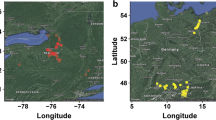Summary
Isozyme analysis was conducted on individuals of Populus alba L., P. tremula L., and P. × canescens Smith to genetically characterize and differentiate species, hybrids, and individuals, and to determine genetic relationships among them. Thirty gene loci, with 71 alleles, coding for 15 enzymes were observed. Individuals could be identified on the basis of their multilocus genotypes. There were 21 unique multilocus genotypes among 23 P. alba clones. Five P. alba clones from Canada were genetically distinct from each other. Each of the 18 P. tremula and 15 P. × canescens clones had unique multilocus genotypes. Thirteen clones had a unique genotype at a single locus. Percentage of polymorphic loci, average number of alleles per locus, and mean observed heterozygosity were, respectively, 50.0, 1.86, and 0.085 in P. alba, 51.7, 1.66, and 0.096 in P. tremula, and 51.7, 1.86, and 0.157 in P. × canescens. Populus alba and P. tremula were genetically distinct from each other and could be distinguished by mutually exclusive alleles at Aco-3, P. tremula-specific gene Mdh-3, and allele frequency differences at 6 loci. Populus × canescens had allele contributions of P. alba and P. tremula. However, their allele frequencies were closer to those of P. alba than being truly intermediate. The mean genetic identity was 0.749 between P. alba and P. tremula, 0.987 between P. alba and P. × canescens, and 0.817 between P. tremula and P. × canescens. Canonical discriminant analysis of multilocus genotypes separated P. alba, P. tremula, and P. × canescens into three distinct groups and portrayed similar interspecific relationship as above. Our results suggested that the putative P. × canescens individuals consisted of a mixture of F1 hybrids of P. alba and P. tremula and their backcrosses to P. alba.
Similar content being viewed by others
References
Anonymous (1958) Poplars in forestry and land use. FAO Forestry and Forest Products Studies No. 12. FAO, Rome
Anonymous (1979) Poplars and willows in wood production and land use. FAO Forestry Series No 10. FAO, Rome
Cheliak WM, Dancik BP (1982) Genetic diversity of natural populations of a clone forming tree Populus tremuloides. Can J Genet Cytol 24:611–616
Cheliak WM, Pitel JA (1984) Electrophoretic identification of clones of trembling aspen. Can J For Res 14:740–743
Dickmann DI, Stuart KW (1983) The culture of poplars in eastern North America. Michigan State University, East Lansing, Michigan
Eckenwalder JE (1977) Systematics of Populus L. (Salicaceae) in southwestern North America with special reference to sect. Aigeiros Duby. Ph. D thesis, University of California, Berkeley, Calif.
Guzina V (1978) Genetic control of isoperoxidases PX-A1, PX-A2, PX-B1 and PX-B2 in aspen (Populus tremula L.). Ann For 8:51–90
Heimburger C (1968) Poplar breeding in Canada. In: Maini JS, Cayford JH (eds) Growth and utilization of poplars in Canada. Can Dep For Rural Dev, Can For Branch Dep Publ 1205, pp 88–100
Hyun JO, Rajora OP, Zsuffa L (1987 a) Genetic variation in trembling aspen in Ontario based on isozyme studies. Can J For Res 17:1134–1138
Hyun JO, Rajora OP, Zsuffa L (1987b) Inheritance and linkage of isozymes in Populus tremuloides Michx. Genome 29:384–388
Hyun SK, Noh ER, Hyun JO (1984) A study for nomenclature and registration for poplar species of the section Leuce and their hybrids. Report submitted to the Subcommittee on Poplar Nomenclature and Registration. XVII Session Int Poplar Comm, Ottawa, Canada, p 53
Muhle Larsen C (1970) Recent advances in poplar breeding. Int Rev For Res 3:1–67
Namkoong G, Roberds JH, Nunnally LB, Thomas HA (1979) Isozyme variation in populations of southern pine beetles. For Sci 25:197–203
Nei M (1978) Estimation of average heterozygosity and genetic distance from a small number of individuals. Genetics 89:583–590
Nei M, Roychoudhury AK (1974) Sampling variances of heterozygosity and genetic distance. Genetics 76:379–390
Peto FH (1938) Cytology of poplar species and natural hybrids. Can J Res 16:445–455
Rajora OP (1988) Allozymes as aids for identification and differentiation of some Populus maximowiczii Henry clonal varieties. Biochem Syst Ecol 16:635–640
Rajora OP (1989a) Genetic structure and identification of Populus deltoides clones based on allozymes. Genome 32:440–448
Rajora OP (1989b) Characterization of 43 Populus nigra L. clones representing selections, cultivars and botanical varieties based on their multilocus allozyme genotypes. Euphytica 43:197–206
Rajora OP (1989c) Identification of some Populus deltoides Marsh. × P. nigra L. clones, developed in North America, with the aid of allozymes. Euphytica 43:207–213
Rajora OP (1990 a) Marker allozyme genes and alleles for differentiation of Populus deltoides, P. nigra, P. maximowiczii and their interspecific hybrids. Can J Bot 68:990–998
Rajora OP (1990b) Genetics of allozymes in Populus deltoides Marsh., P. nigra L., and P. maximowiczii Henry. J Hered 81:301–308
Rajora OP, Zsuffa L (1989) Multilocus genetic structure, characterization and relationships of some Populus × canadensis cultivars. Genome 32:99–108
Rajora OP, Zsuffa L (1990) Allozyme divergence and evolutionary relationships among Populus deltoides, P. nigra and P. maximowiczii. Genome 33:44–49
Rajora OP, Dancik BP, Aleksiuk M (1991) Associations of allozyme genes encoding peroxidase and Superoxide dismutase enzymes in poplar and spruce species. Theor Appl Genet 81:729–734
Ridgeway GJ, Sherburne SW, Lewis RD (1970) Polymorphisms in the esterases of Atlantic herring. Trans Am Fish Soc 99:147–151
Schaal BA, Anderson WW (1974) An outline of techniques for starch gel electrophoresis of enzymes from the American oyster Crassostrea Virginica Gmelin. Georgia Marine Sci Center Tech Rep Ser No 74-3
Siciliano MJ, Shaw CR (1976) Separation and visualization of enzymes on gels. In: Smith I (ed) Chromatographic and electrophoretic techniques, vol 2. Heinemann, London, pp 185–209
Spies TA, Barnes BV (1982) Natural hybridization between Populus alba L. and native aspens in southeastern Michigan. Can J For Res 12:653–660
Zsuffa L (1975) A summary review of interspecific breeding in the genus Populus L. In: Fowler DP, Yeatman CW (eds) Proc 14th Meet Can Tree Improvement Assoc, part 2. Canadian Forestry Service, Ottawa, pp 107–123
Author information
Authors and Affiliations
Additional information
Communicated by H. F. Linskens
Presently with the University of Alberta, and BioGenetica Inc., P.O. Box 8261, Edmonton, Alberta, Canada T6H 4P1
Rights and permissions
About this article
Cite this article
Rajora, O.P., Dancik, B.P. Genetic characterization and relationships of Populus alba, P. tremula, and P. x canescens, and their clones. Theoret. Appl. Genetics 84, 291–298 (1992). https://doi.org/10.1007/BF00229485
Received:
Accepted:
Issue Date:
DOI: https://doi.org/10.1007/BF00229485




